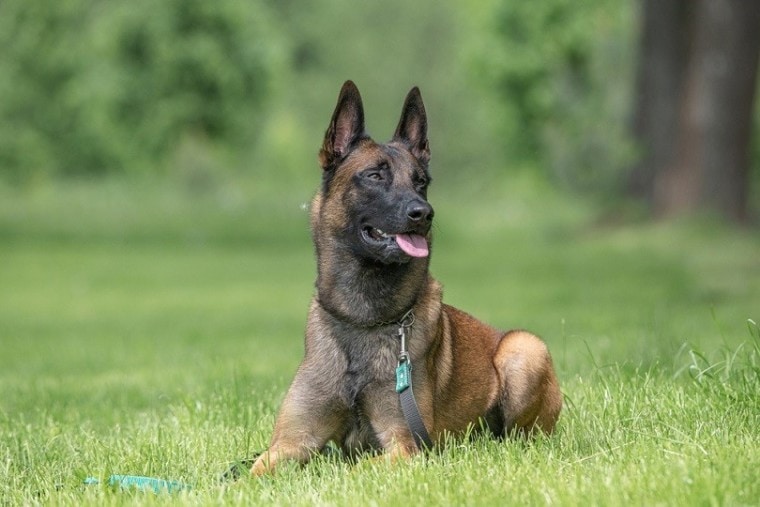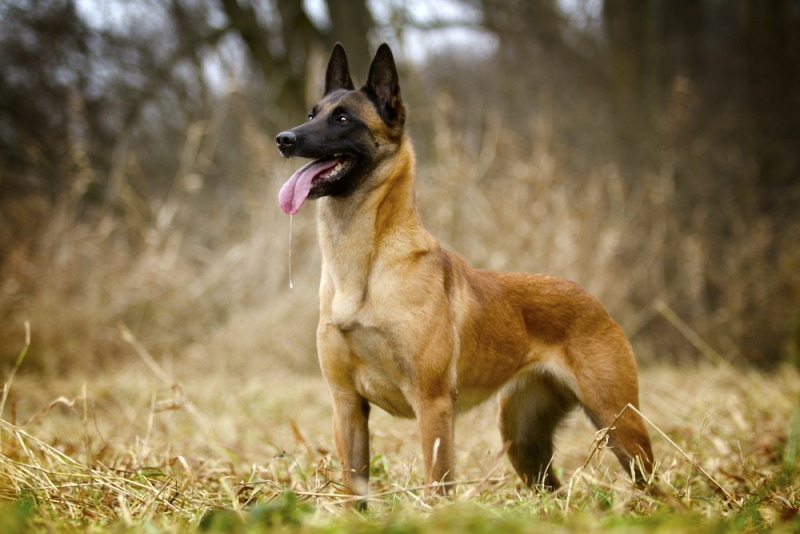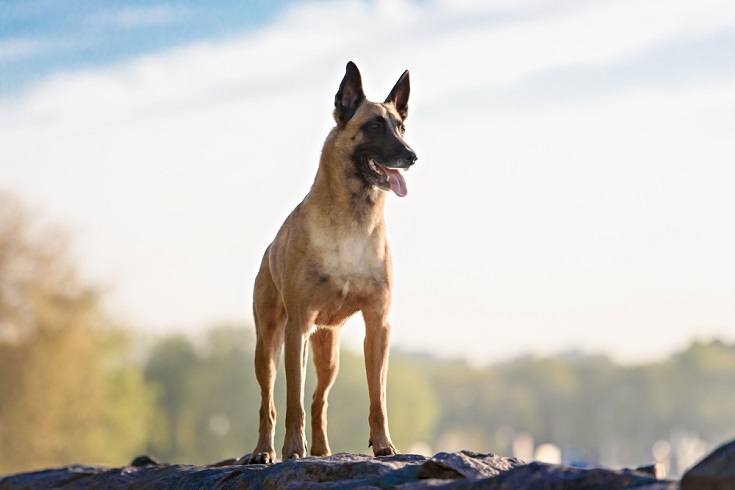
Click Below to Skip Ahead
The Belgian Malinois is an alert herding dog that weighs somewhere between 40 and 80 pounds. They are well-built and confident in their abilities. They aren’t bulky but are covered with lean muscle. They are a practical dog, through and through. Their appearance doesn’t have many frills. They look like a working dog.
Breed Overview
Height:
22 – 24 inches (female), 24 – 26 inches (male)
Weight:
40 – 60 pounds (female), 60 – 80 pounds (male)
Lifespan:
14 – 16 years
Colors:
Fawn with black
Suitable for:
Active families
Temperament:
Outgoing, hardworking, intelligent
Their coloration can vary from fawn to mahogany, but any Belgian Malinois will fall somewhere within this tan range. They have a black mask and similarly dark eyes.
This breed is well-known for being smart and eager. They are great at obedience, able to learn just about any command, and are willing to follow their owner’s directions. They are people-oriented, so they do need quite a bit of attention. Their intelligence also means they need significant amounts of mental and physical stimulation, which can be challenging for some families to handle.
Their high exercise needs can be quite intense. They are extremely active working dogs, which means that they require huge amounts of exercise daily. You can’t put them in a backyard and expect them to meet their own needs. They thrive best when given a job to do.
Belgian Malinois Characteristics
Belgian Malinois Puppies
These dogs are extremely sought after due to their high intelligence and physical prowess. They have overtaken many other popular breeds for use in military and police work. If you’re looking for a protection or guard dog, you can’t get much better than a Belgian Malinois.
Typically, pet quality pups are just as smart and capable as more expensive puppies. However, they could have a slight “problem” that makes them unable to compete in shows. For example, they may be too dark in color, or their black face mask may not be exactly right. Since they likely won’t be used for breeding, they are often cheaper than other puppies. If you’re just looking for a pet, there is no reason to skip over these cheaper puppies. Often, they will be exactly what you’re looking for.
Temperament & Intelligence of the Belgian Malinois

This dog is well-known for being highly intelligent. They can learn just about anything and are likely one of the smartest dog breeds in the world. They can learn commands and often have the self-control to follow those commands. They can stop in mid-attack and switch to a different attacker, which is one reason that they are so useful for military situations.
In a companion animal, this means you’re getting a dog that can be reliably recalled from many situations. Even if they are engrossed in playing with another dog, a well-trained Belgian Malinois will happily come back to you at your call. It is this level of intelligence and self-control that makes them one of the most trainable dogs in the world.
They are vigilant and can make good guard and alert dogs. They aren’t necessarily noisy, though, especially if they are trained to remain quiet unless told otherwise. They have a strong guarding instinct that is suitable for those looking for a protection animal. However, as long as they are trained properly, they typically don’t pose a danger to others. Of course, this only applies to well-socialized and well-trained dogs. Those that are not properly socialized can be wary of strangers.
These dogs do need training from a young age. Their high intelligence makes them extremely trainable, but this also means that they need a great deal of mental stimulation. Without this, they can become bored, which can lead to destructiveness. Bored dogs will attempt to make their own fun, which typically leads to chewing and similar behaviors.
They are territorial and tend to be a bit aloof of strangers. This can be partially counteracted by early socialization with a broad range of people and animals. Of course, training can also help with this, especially if you teach your dog commands like “calm.”
They are extremely active but not necessarily hyperactive like some smaller dogs. They aren’t excitable, but they do require extensive amounts of exercise regularly. You should plan on spending hours a day keeping them in shape. Otherwise, they may misbehave and look for other ways to entertain themselves, such as chewing up your furniture.
They do best in a larger home or one with a fenced-in backyard. They aren’t well-adapted to smaller spaces unless you take them on multiple walks a day. We do not recommend these dogs for apartment living.

Are These Dogs Good for Families? 👪
Yes, they make devoted and loving family pets. They are not aggressive toward their people, which is one reason that they are commonly used as protective dogs. They can get along well with children if introduced to them from a young age. Otherwise, they may be a bit wary of a child’s loud and often hyperactive behavior. They are people-oriented and love to take part in anything that your family is doing. Whether you want to hike or spend the day at the beach, this dog is perfect.
However, they do require quite a bit of exercise and mental stimulation. They are not best for people that are gone much of the time. You can’t just leave these dogs home all day, which can be a barrier for many families. They also require the family to be quite active, as they have extremely high exercise needs. They are more high-maintenance than most other dog breeds out there.
Children should be taught not to tease these dogs, as they do not react well. Adult supervision is required when the dog is around any children, especially children that the dog does not know. The dog often feels protective toward the children in their own family, but this doesn’t always extend to other children.
They also have a strong herding instinct, though it isn’t necessarily as strong as some other herding breeds. This may cause them to chase fast-moving objects, like children. You should be careful when introducing a dog to children if they were not raised around kids, as chasing can lead to accidental injury.
Does This Breed Get Along With Other Pets?
The Belgian Malinois can be aggressive toward dogs and other animals if they are not socialized from an early age. This is due to their territorial nature, which may cause them to automatically register other dogs as enemies. Early socialization can curb this problem, though. If you introduce them to many dogs when they are puppies, they often grow up to react well to other canines.
They do have a strong chase drive, which can get them into trouble with cats. However, because they are herding dogs, they don’t typically actually hurt the cat. Of course, anything can happen when you throw a large dog in a room with a cat. Early socialization can help them understand that cats are family members too.
They typically get along fine with livestock and other animals, as they were originally bred as herding dogs.

Things to Know When Owning a Belgian Malinois
Food & Diet Requirements 🦴
The Belgian Malinois is an active, working dog. They do not require any particular diet compared to other dogs. However, we do recommend feeding them a high-quality diet due to their high activity. Like any athlete, these dogs may not perform their best if they are not fed properly.
A high-quality diet should comprise plenty of protein and meat. Meat sources should be the first few ingredients in the food. Whole meat and meat meal are preferable. Meat meal is simply meat that has been cooked down and dehydrated, which makes it more nutritious per ounce than whole meat.
This does not mean feeding your dog a grain-free diet, though, as grain-free diets have been potentially linked to health problems. This is likely because grain-free diets simply replace the grain with low-quality, cheap veggies, like peas. These recipes often don’t actually include more meat. You’re better off choosing a grain-inclusive food that is high in meat unless your dog has a grain allergy.
Any dietary changes should be done slowly over the course of a few days. We do recommend changing their food often, as this helps prevent dietary deficiencies. If you switch your dog’s main protein source, you can also prevent food allergies.
For dogs that work particularly hard, you should add electrolytes to their water. This is often recommended for dogs involved in law enforcement. However, these canines tend to be extremely hardworking, so the average companion dog may not need them.

Exercise 🐕
These dogs are extremely active and prefer to get their exercise needs met when next to their human companions. They are athletic and muscular, so they need quite a bit of exercise to thrive. Otherwise, they can become bored and turn to destructive behaviors to stay happy and healthy. They cannot simply be kept in the backyard, and a single, daily walk often isn’t enough either. Playtime in the backyard, as well as canine sports, are required to keep these dogs healthy, so plan on spending hours with these dogs each day to meet their exercise needs.
We recommend combining their exercise needs with their need for human companionship and mental stimulation. Agility training and similar sports are great for this, as they challenge the dog’s mind and body at the same time. Even if you don’t plan on competing, having a few obstacles that you can set up is an easy way to wear your dog out.
Hiking, biking, and running are also good options. These dogs can be trained to run next to a bike, which may be a good option instead of the usual walk.
Training 🎾
These dogs are extremely trainable. In fact, they are one of the most trainable dog breeds out there. Unlike other breeds, their intelligence is functional in that they will use it in a training situation. They aren’t stubborn by any means and will listen to anyone in their family, even small children. They enjoy following commands.
They have a strong prey drive like most herding dogs, which will cause them to chase moving objects in an attempt to herd them. This is true for smaller objects, like cats, as well as larger objects, like cars. This can’t be completely trained out, but the instinct can be directed toward other activities, such as agility or coursing. They do not have as high of a prey drive as some other breeds, allowing them to get along with cats if socialized properly.
Early socialization and obedience training is a must for this breed. We absolutely recommend puppy classes with an experienced trainer. This will help you figure out how to train your puppy and get them to socialize with other dogs.
You should get these dogs out into the world when puppies so they are not fearful as adults. Take them on walks in the park and into dog-friendly establishments. Let them meet tons of strangers and other animals.
Grooming ✂️
The Belgian Malinois’s short coat is easy to take care of. It is weather-resistant, so it tends to stay clean by itself. You should brush them occasionally with a rubber grooming mitt or similar tool. This will remove any loose hair and debris in their coat, as well as distribute their natural oils that help keep their coat clean. You can also promote new hair growth through brushing.
They do shed their coat heavily about twice a year. During this time, you should brush them daily with a slicker brush. This will remove their loose hairs, making them feel more comfortable and preventing all the fur from ending up on the furniture.
You will need to trim their nails regularly to prevent cracking and splitting. Overly long nails can make it painful to walk. Even though these dogs are quite active, they will likely not wear down their paws naturally enough. Their teeth should be cleaned to prevent dental problems. You should check their ears for a buildup of debris. They aren’t particularly prone to ear problems, but dirt can cause ear infections if not cleaned.

Health and Conditions 🏥
If exercised appropriately and trained correctly, these dogs are typically rather healthy. However, improper breeding and diet and a lack of stimulation can cause a few health problems. This is especially true if you adopt from a backyard breeder that does not do the proper testing before breeding two dogs together.
These dogs can be prone to hip and elbow dysplasia, which is caused by a mixture of genetics and diet. If a puppy consumes too many calories while growing, their hip socket can grow incorrectly, and they can end up with hip dysplasia. These dogs may also be prone to certain eye conditions, like progressive retinal atrophy (PRA) and cataracts, which also have a genetic component.
The Belgian Malinois Club of America participates in the Canine Health Information Center Program, which helps ensure that dogs are properly tested before being bred. A Belgian Malinois can achieve CHIC certification by having their hips tested, as well as an eye clearance. This ensures that there are no genetic problems with the dog before they are bred. All results are published in the CHIC database, even if they are positive. You should ask any breeder for a copy of the dog’s certification and visit the CHIC’s website.
You should not purchase a puppy if the breeder has not undergone this testing, as the puppy could have inherited genetic problems. Having the dog checked by a vet is not enough, as many of these genetic conditions are not present until the dog is older.
Male vs. Female
Male Belgian Malinois are far larger than females. In some cases, they can be nearly double the size. Females tend to be a bit easier to handle because they are smaller, but males can obviously offer more protection due to their larger size.
It is mostly a matter of what you’re looking for in a dog. Males may be more territorial, but this may mostly be a matter of socialization. You’ll be able to counteract any excessive territorial behavior with regular training and socialization, so don’t necessarily avoid males for this reason.
3 Little-Known Facts About the Belgian Malinois
1. The Belgian Malinois is one of the four types of Belgian herding dogs.
These dogs are often grouped as the Belgian Shepherd. However, they are often considered to be their own breeds, as they are extremely different from each other. The AKC considers these dogs to all be separate breeds, but other organizations still have them listed as one breed. It mostly just depends on who you ask.
2. They were originally a herding dog.
While these dogs are mostly used for military and police work today, they are historically used as sheep herding dogs. This is often why they are grouped in with other herding dogs. However, they are mostly used for protection purposes today and as family dogs. Other herding dogs have largely taken over sheep herding.
3. Cairo, a Belgian Malinois, played an important role in taking down Osama Bin Laden.
During the 2011 raid that took down this notorious terrorist, a Belgian Malinois played a critical role. This dog was previously injured during a fight with insurgents in 2009 but happily returned to work after he healed. He is now retired and living with one of his military handlers.

Final Thoughts
The Belgian Malinois originally started as a herding dog. However, they are now mostly used for protection purposes. The military and police force utilize these dogs. If you’re looking for a highly trainable dog, this may be the canine that you’re looking for.
However, their high intelligence and physical prowess mean that they are a bit more work than other dogs. They require a significant amount of exercise and mental stimulation. This often means quite a bit of work for most families. They aren’t a dog that you can leave at home for much of the day. You should plan on spending a few hours with this dog every day, exercising them and training them.
They are people-oriented and can make good family dogs when properly handled. They do require socialization and training while puppies, so plan on devoting quite a bit of time to their upbringing.
- See Also: Belgian Malinois Price: Cost Breakdown
Featured Image Credit: shymar27, Shutterstock







